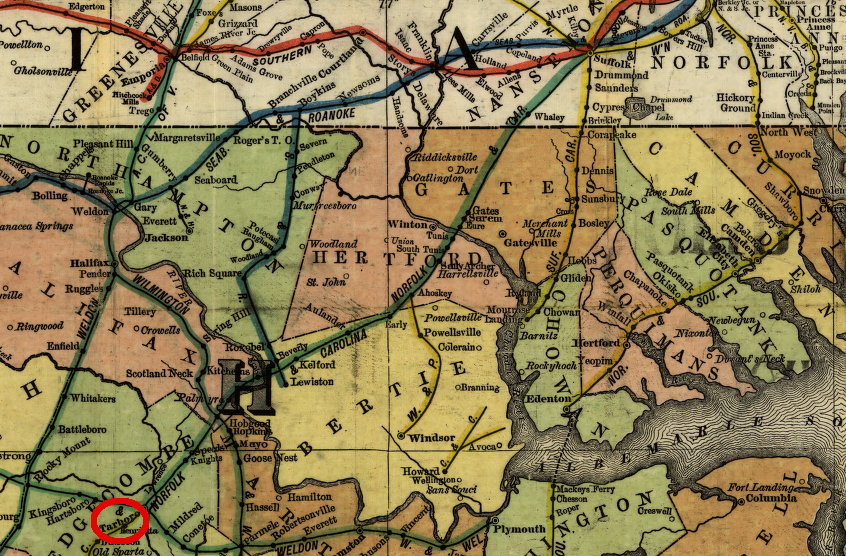
the Norfolk & Carolina Railroad connected to the Wilmington and Weldon at Tarboro, south of the Seaboard and Roanoke connection at Weldon, North Carolina
Source: Library of Congress, Railroad map of North Carolina, 1900 (H. C. Brown, 1900)

the Norfolk & Carolina Railroad connected to the Wilmington and Weldon at Tarboro, south of the Seaboard and Roanoke connection at Weldon, North Carolina
Source: Library of Congress, Railroad map of North Carolina, 1900 (H. C. Brown, 1900)
The first attempt to build a railroad between Norfolk and the Tar River in North Carolina was in response to the construction of the Petersburg Railroad, which received a charter in 1830 to intercept boat traffic coming down the Roanoke River. The Petersburg Railroad diverted freight to Petersburg by providing a less-expensive alternative to floating down to the Chowan River, then using the Dismal Swamp Canal to reach Portsmouth or Norfolk.
The Petersburg Railroad reached the banks of the Roanoke River, opposite Weldon and north of the Tar River, in 1833. Business leaders in Portsmouth and Norfolk recognized that grain, tobacco, cotton, and other crops which had been coming down the Roanoke River and via the Dismal Swamp Canal to their port cities would start going instead to the rival port of Petersburg.
Two railroads were proposed to compete with Petersburg Railroad and draw more trade to Hampton Roads. One option was the Tarborough Railroad, proposed to be constructed to the Tar River at Tarborough. The other choice was to build the Portsmouth and Roanoke Railroad, which would connect to the Roanoke River at Weldon.
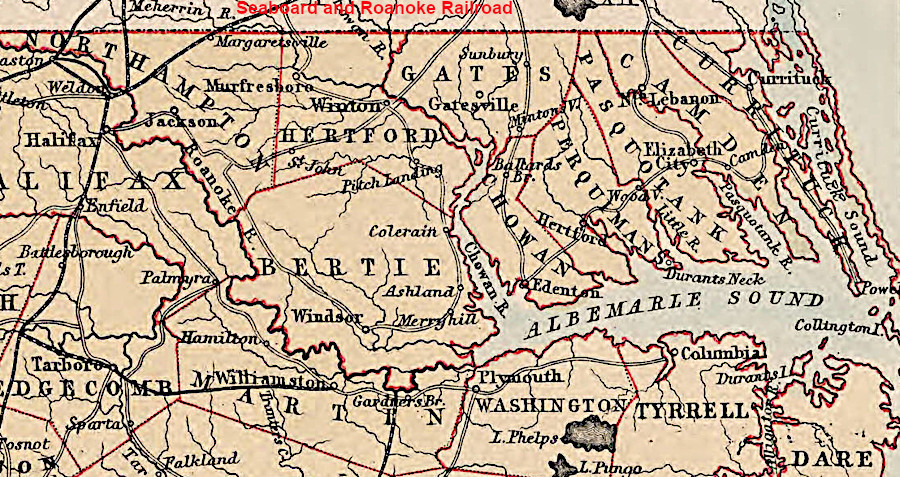
in 1880, only the Seaboard and Ranoke Railroad linked northeastern North Carolina to ports on the Elizabeth River in Virginia
Source: Library of Congress, North & South Carolina (published by Adam and Charles Black between 1876 and 1879)
The Portsmouth and Roanoke Railroad was judged to offer the best potential to steer trade back to the Elizabeth River, and that line was completed in 1837. It took another 53 years before track was laid from Portsmouth to the Tar River at Tarboro. The Norfolk & Carolina Railroad started running trains on that route in 1890.1
Peter C. Stewart, "Railroads and Urban Rivalries in Antebellum Eastern Virginia," The Virginia Magazine of History and Biography, Volume 81, Number 1 (January, 1973), p.5, https://www.jstor.org/stable/4247766 (last checked January 20, 2019)
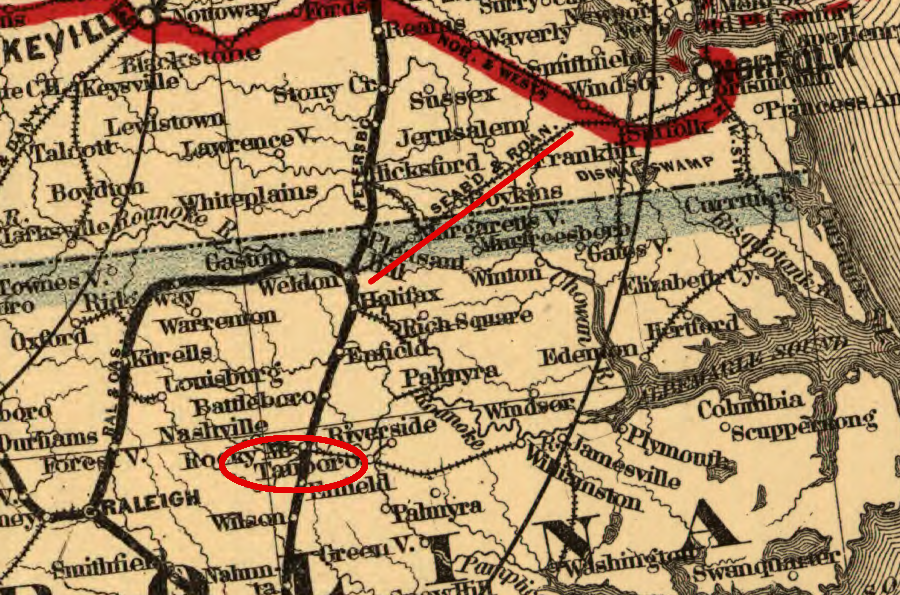
prior to the Norfolk & Carolina Railroad reaching Tarboro, freight from North Carolina reached Norfolk via the Portsmouth and Roanoke (later Seaboard and Roanoke) Railroad
Source: Library of Congress, Map showing the Norfolk & Western Railroad and its connections (G.W. & C.B. Colton & Co, 1887)
The Norfolk & Carolina Railroad was chartered initially in 1887 as the Chowan & Southern Railroad. Both the Virginia and North Carolina legislatures authorized construction that year. The Chowan and Southern Railroad was renamed in 1889. Calling it the Norfolk & Carolina Railroad reflected plans to go further southwest, beyond the Chowan River.2
"An Act to Incorporate the Chowan and Southern Railroad Company," May 5, 1887, Acts and Joint Resolutions of the General Assembly of the Commonwealth of Virginia, Cmmonwealth of Virginia, 1887, p.185, https://books.google.com/books?id=xuJJAQAAMAAJ; "North Carolina Railroads - Chowan & Southern Railroad," Carolana, http://www.carolana.com/NC/Transportation/railroads/nc_rrs_chowan_southern.html (last checked January 19, 2019)
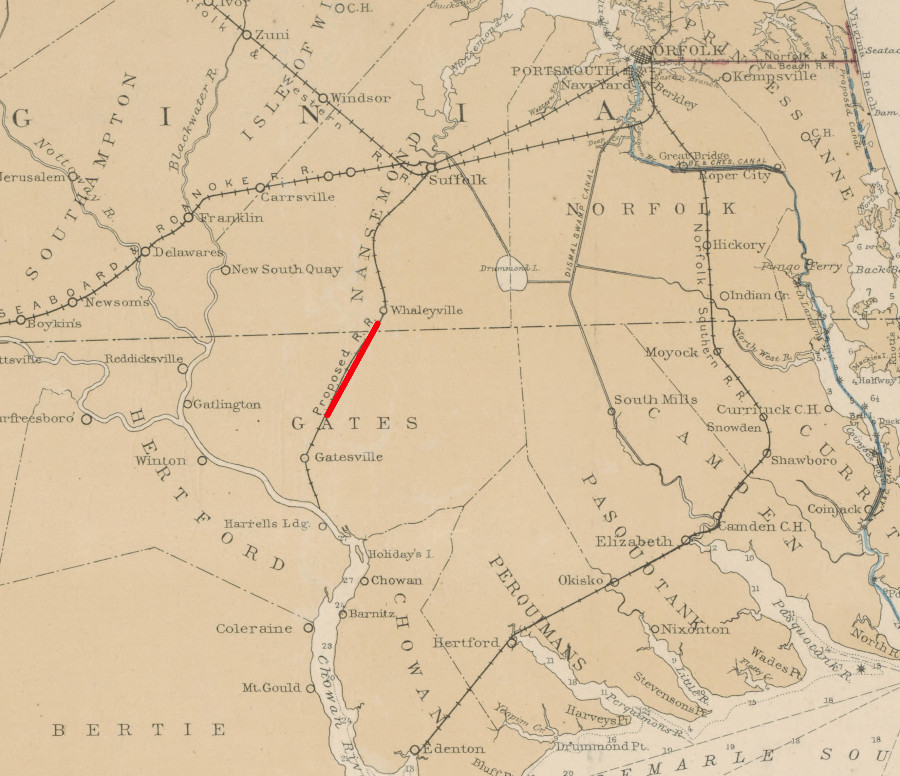
the original proposal for what became the Norfolk & Carolina Railroad was to build only to the Chowan River
Source: University of North Carolina, Map of the Albemarle and Chesapeake Canal: connecting Chesapeake Bay with Currituck, Albemarle and Pamplico sounds and their tributary streams (by A. Lindenkohl and Henry Lindenkohl, 1885)
In 1888 the Chowan and Southern Railroad absorbed the Western Branch Railway, which had been chartered in 1886. That railroad had been constructed in 1888, going inland 12 miles from Pinners Point to Drivers, Virginia.
1
"Norfolk and Carolina Railroad Company," Annual Report, Virginia, Railroad Commissioner, 1898, p.96, https://books.google.com/books?id=mCUaAQAAIAAJ (last checked June 2, 2020)
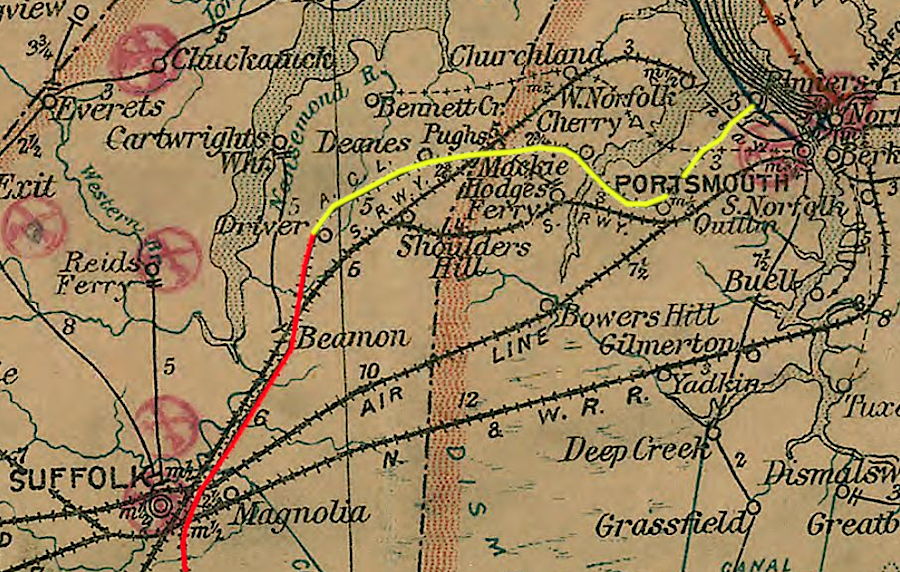
the Norfolk & Carolina Railroad (and later the Atlantic Coast Line) used the route of the Western Branch Railway from Drivers to Pinners Point (yellow)
Source: Library of Congress, Post route map of the states of Virginia and West Virginia (1906)
The Western Branch Railway enabled farmers on the Elizabeth River to ship produce via the New York, Philadelphia & Norfolk Railroad to New York, Boston, and other markets in the Northeast.
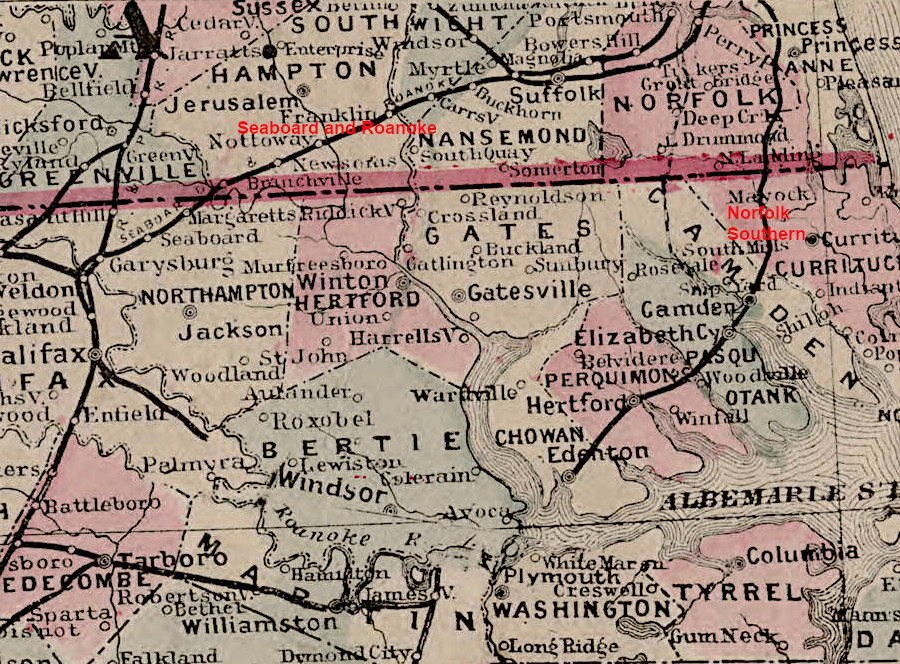
the Norfolk & Carolina Railroad serviced territory between the "original" Norfolk Southern to the east and the Seaboard and Roanoke Railroad to the north
Source: University of North Carolina, New railroad and county map of North Carolina (by George Franklin Cram, 1880's)
The new Norfolk & Carolina Railroad railroad began operations in 1890. It created yet another connection from the Piedmont and Coastal Plain of North Carolina to the Chesapeake Bay.
It connected Pinners Point on the Elizabeth River to the Wilmington & Weldon Railroad 100 miles away at Tarboro. There was no need to build more track to the west of the Tar River; the Wilmington & Raleigh (Wilmington and Weldon) Railroad had constructed a branch line to Tarboro before the Civil War.
The Pinners Point terminal at the northern end of the Norfolk & Carolina Railroad, on the opposite (southern) side of Western Branch from the Atlantic and Danville Railroad terminal at Port Norfolk, offered better access to markets than the port of Wilmington. Ships cabable of carrying timber and other agricultural products to customers in the Northeastern United States and Europe preferred to come to Chesapeake Bay ports, avoiding the hazards of sailing past Cape Hatteras and the Outer Banks to Charleston or Savannah.3
Lauren DiBianca, "How Natural Features, Industrialization, and Ethnicity Shaped Sugar Hill ," December 2007, pp.10-12, http://web.arch.virginia.edu/learningbarge/Community%20History%20Website/Website%20Edit/Sugar_Hill/SugarHillshaped.pdf; "North Carolina Railroads - Wilmington & Weldon Railroad," Carolana, http://www.carolana.com/NC/Transportation/railroads/nc_rrs_wilmington_weldon.html (last checked December 25, 2018)
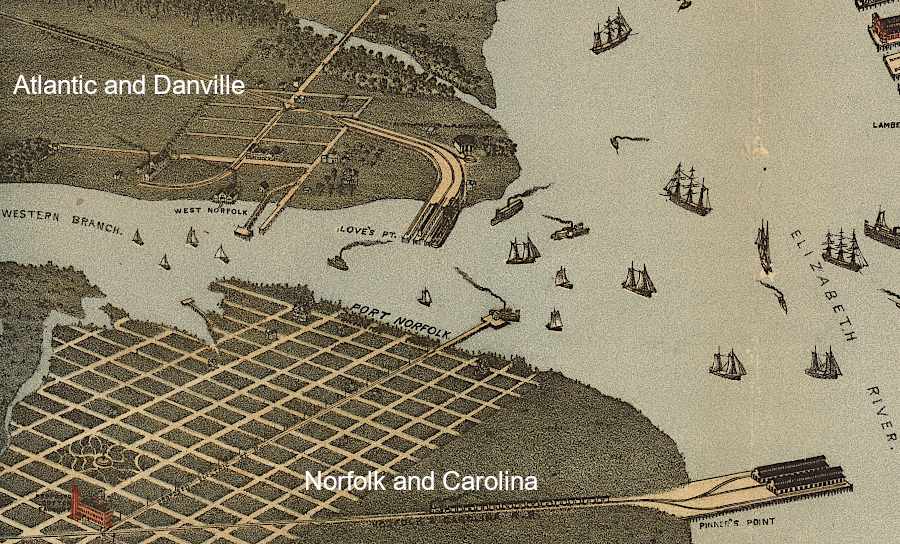
the Norfolk & Carolina and the Atlantic and Danville railroads had Elizabeth River terminals on opposite sides of Western Branch
Source: Library of Congress, Bird's eye view of Norfolk, Portsmouth and Berkley, Norfolk Co., Va (1891?)
The Norfolk & Carolina Railroad had limited capacity to expand east and west via branch lines. To the west, the Seaboard and Roanoke Railroad owned the Roanoke and Tar River Railroad. To the east, shippers could choose to use the rival Suffolk and Carolina Railway. To generate more traffic, the Norfolk & Carolina Railroad needed to extend further west into the Piedmont of North Carolina.
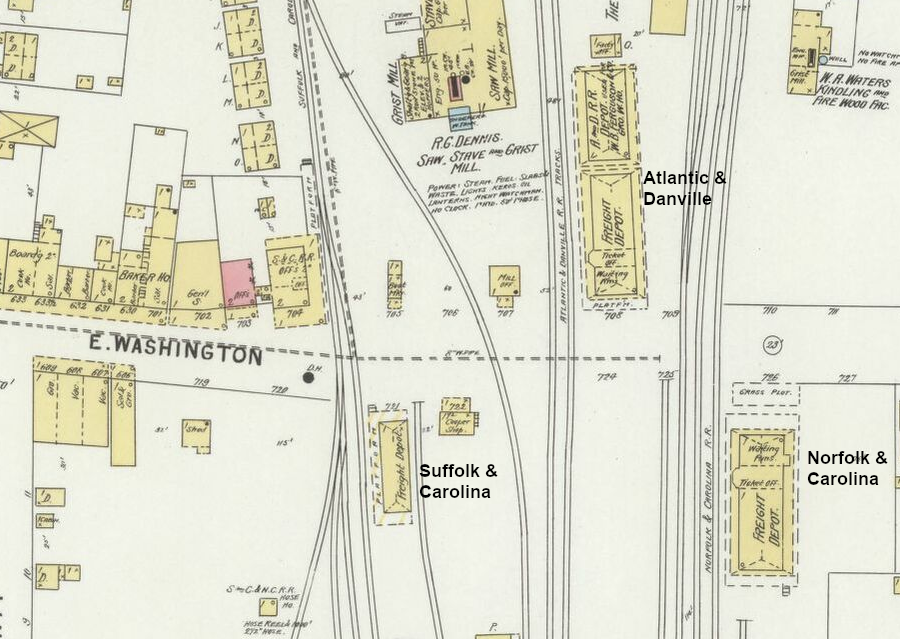
competing railroads in Suffolk built separate freight depots
Source: Library of Congress, Sanborn Fire Insurance Map from Suffolk (Sanborn Map Company, April 1898)
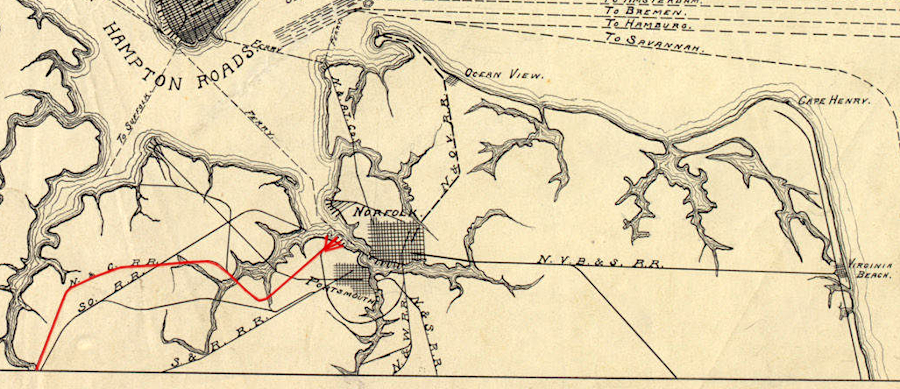
the Norfolk & Carolina Railway had access to the Elizabeth River
Source: Newport News Public Library, Jamestown Ter-Centennial Map (Map Collection of the Old Dominion Land Company)
To get more freight traffic, the Norfolk & Carolina Railroad aligned with other railroads that formed the Atlantic Coast Line partnership. Its connection to Pinners Point, where deepwater ships could dock, was particularly valuable.
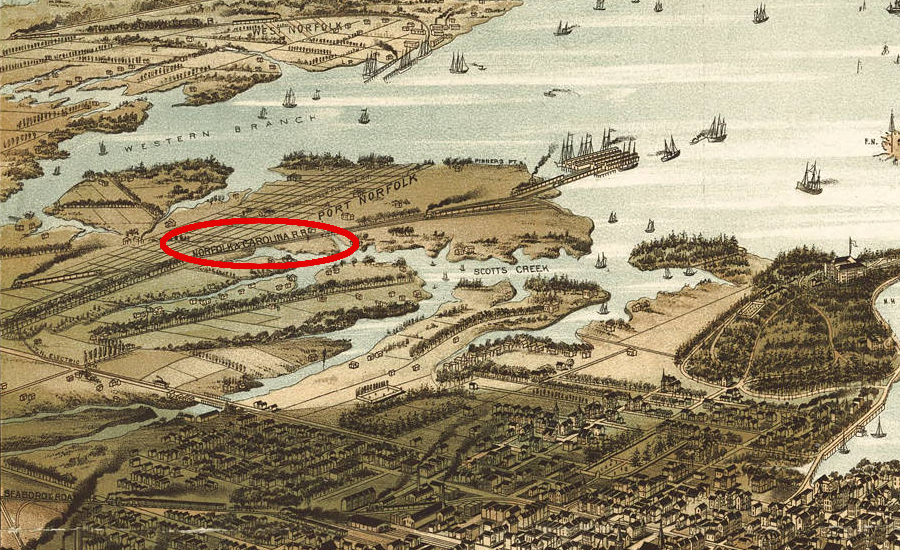
the Norfolk & Carolina Railroad built wharves at Pinners Point on the Elizabeth River, site of Portsmouth Marine Terminal today
Source: Norfolk Public Library, Panorama of Norfolk and Surroundings, 1892
The Atlantic Coast Line negotiated a deal with the Southern Railway in 1895, a year after the Southern Railway formed. The Atlantic Coast Line granted the Southern Railway "trackage rights" across the old Norfolk & Carolina Railroad, providing access to the wharves at Pinners Point on the Elizabeth River.
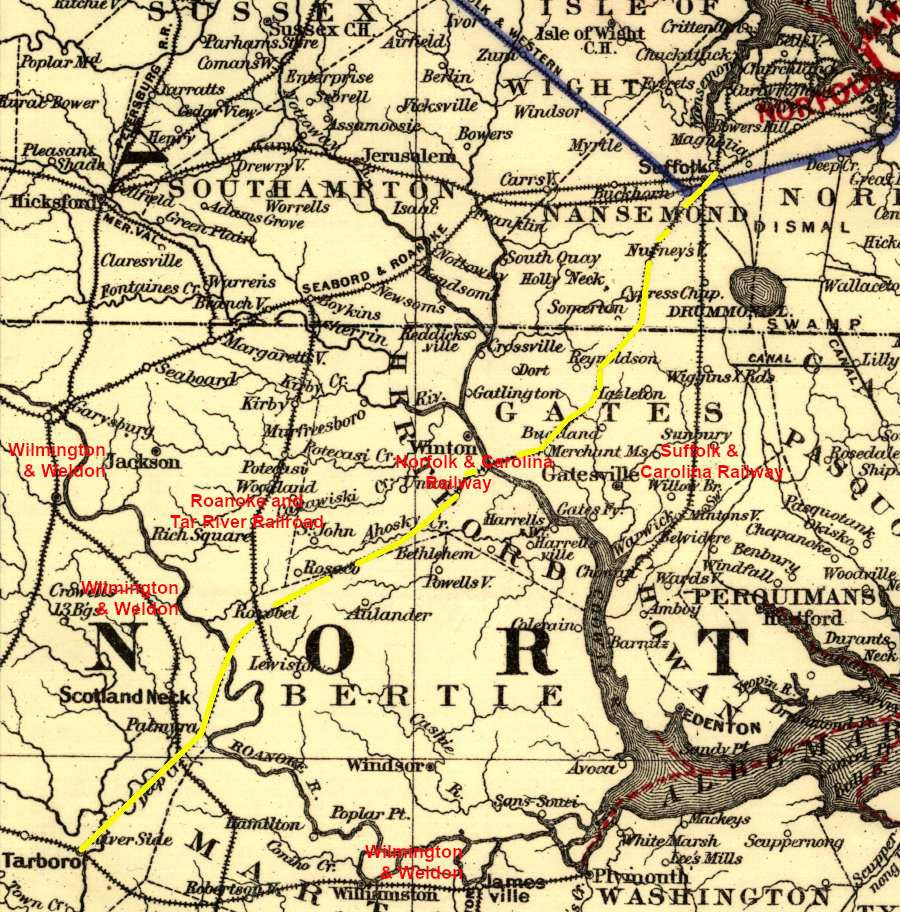
the Norfolk & Carolina Railway in 1891, with competing lines on the east and west going to Suffolk
Source: Library of Congress, Maps showing the Norfolk, Albermarle & Atlantic Railroad and its connections (G.W. & C.B. Colton & Co., 1891)
Both the Atlantic Coast Line and the Norfolk & Carolina Railroad built new piers in 1896.
4
William E. Griffin Jr., The Atlantic and Danville Railway Company, TLC Publishing, 2006, p.9
The track from Tarboro to Pinners Point became a key segment in the Atlantic Coast Line, which made Pinners Point its primary terminal on the Chesapeake Bay. When the Atlantic Coast Line Railroad was incorporated in 1900, the Norfolk & Carolina Railroad was folded into the new corporation and lost its independent status.5
"North Carolina Railroads - Norfolk & Carolina Railroad," Carolana, http://www.carolana.com/NC/Transportation/railroads/nc_rrs_norfolk_carolina.html (last checked November 28, 2018)
When the Atlantic Coast Line merged with the Seaboard Air Line to create the Seaboard Coast Line in 1967, the old route of the Portsmouth and Roanoke (Seaboard and Roanoke) Railroad became the main line carrying traffic from Weldon to Pinners Point. Almost all of the stretch of track between the Chowan River north to Suffolk was abandoned.
After CSX acquired the Seaboard Coast Line in 1983, it created a new shortline railroad called the North Carolina & Virginia Railroad. Today that shortline uses part of the old Norfolk & Carolina Railroad route to carries freight to and from the Nucor Steel minimill on the Chowan River south to Kelford, North Carolina.
The North Carolina & Virginia Railroad does not continue further west to Tarboro, but instead turns north at Kelford. It uses the old Roanoke and Tar River Railroad route going north to connect to the CSX at Boykins, and on to the shipping terminals on the Elizabeth River.6 Edward A. Lewis, "American Shortline Railway Guide," Kalmbach Publishing, 1996, p.227, https://books.google.com/books?id=3i6K_Nf9e2EC (last checked June 21, 2018)
Today, a branch line of the CSX still follows the Norfolk & Carolina Railroad route to South Suffolk, near the Suffolk Executive Airport. It serves a company that mixes fertilizers for farming and a cold storage warehouse.

CSX still uses a tiny piece of the Norfolk & Carolina Railroad route for a branch line south of Suffolk
Source: Virginia Department of Rail and Public Transportation, Virginia Railroad Map
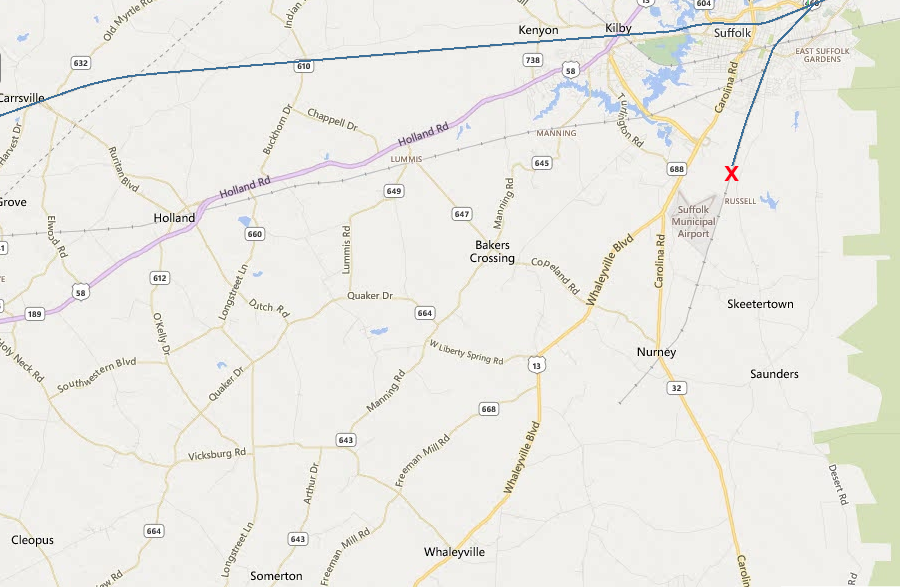
CSX service stops north of the airport, and the railroad no longer operates south to Nurney
Source: CSX, CSX System Map
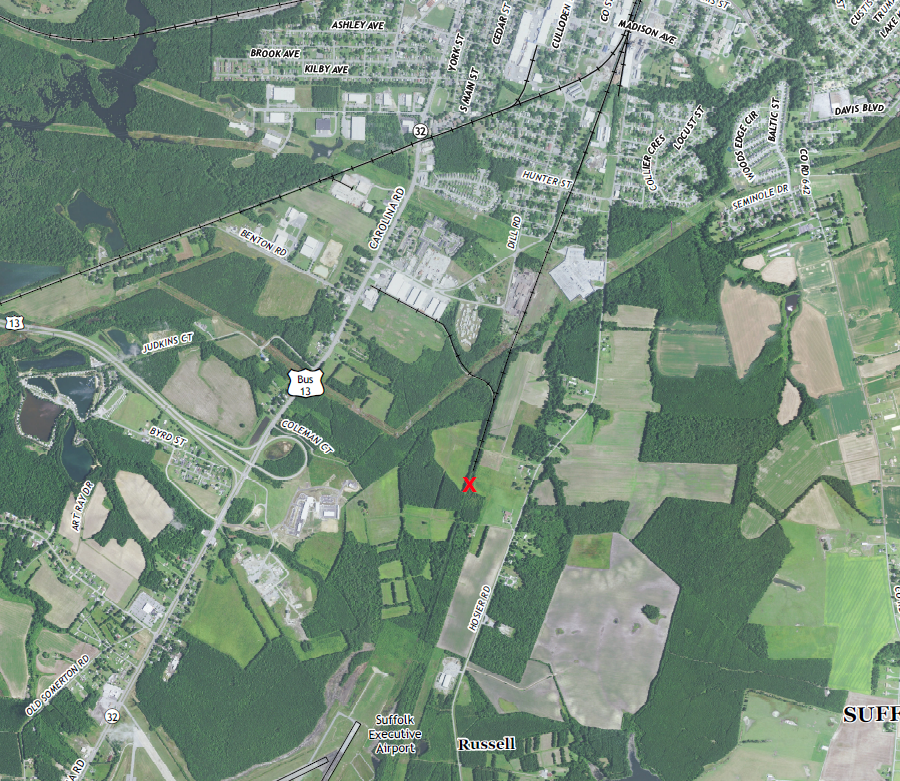
CSX maintains enogh track for trains to turn and access a cold storage warehouse on US 13
Source: US Geological Survey (USGS), Suffolk VA 1:24,000 topographic quadrangle (2019)
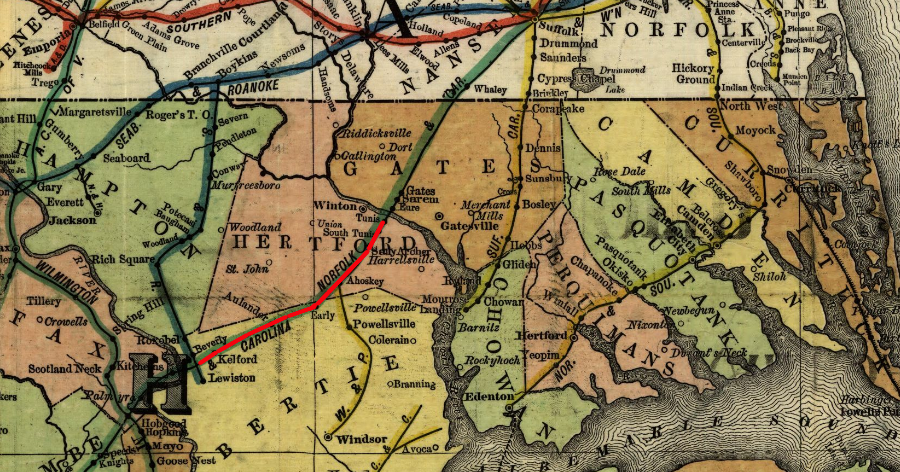
the remaining part of the Norfolk and Carolina Railroad still in use goes from Tunis to Kelford, North Carolina
Source: Library of Congress, Railroad map of North Carolina, 1900, examined and authorized by the North Carolina corporation commission (H. C. Brown, 1900)
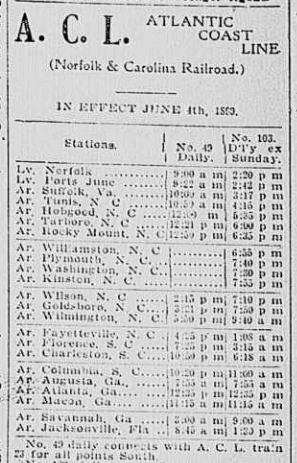
the Norfolk & Carolina Railroad was incorporated into the Atlantic Coast Line
Source: Library of Congress, Chronicling America, Virginian-Pilot (p.9, December 23, 1899)